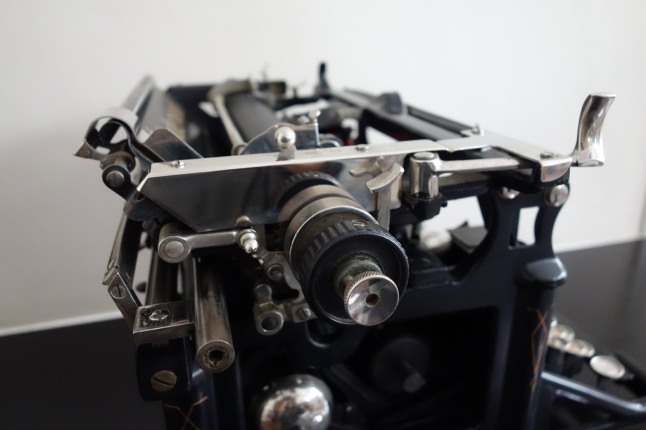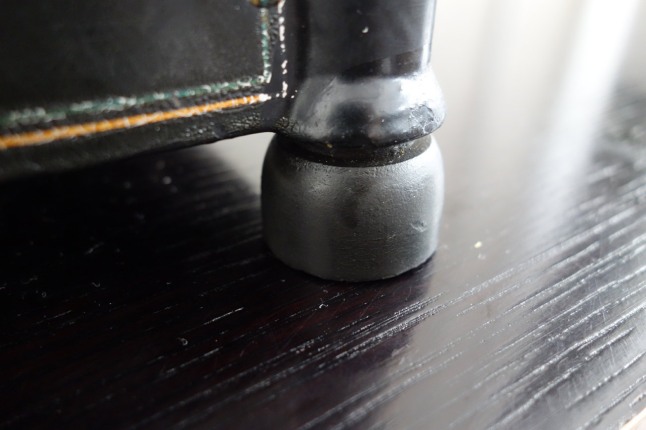It is not true that people stop pursuing dreams because they grow old, they grow old because they stop pursuing dreams.
–Gabriel García Márquez
I think the same can be said of typewriters:
It is not true that typewriters stop typing because they grow old, they grow old because they stop typing.
– Anonymous typospherian
I recently met a victim of disuse at Moe’s shop, a hundred year-old typewriter that aged prematurely because no one has recently typed on it.
A lady wanted to buy it, but it wasn’t working. Moe asked me if I could look at it.
1915 Underwood No. 5
Serial number: 827461
Oh, it’s a thing of beauty and a technological marvel.
I haven’t experienced an Underwood 5 before, so I was surprised at how smallish and compact it is. It does weigh a full ton – it’s dense with superior mechanics.
This Underwood is solid quality through and through. This is a true $100 machine ($2,345.70 in 2016 dollars per the CPI inflation calculator at BLS).

Look at all those thickly-plated levers and buttons and knobs and rods and switches and wheels. Careful of the fingers, kids.

When I brought the Underwood home, the carriage initially eked out a sluggish, gummy crawl on typing. It did not want to move. It was just dirty and lethargic from lack of exercise. I cleaned and lubricated the carriage rails with PB B’laster and moved the carriage back and forth until it glided smoothly. I put a new ribbon in it. It was typing better, but there didn’t seem to be enough “oomph” to reach the end of the line. I added a little tension to the mainspring using the ratchet crank on the mainspring drum in back.

And away we went.

I think this beautiful old machine had some serious maintenance in the last twenty years or so. The feet are soft as a baby’s bottom and the platen, though a little ridged, is nice and soft.

Someone loved this machine and took care of it.
It’s in remarkable condition – hardly any rust or tarnish on it. A little dusty, a little gummy before cleaning, but otherwise just beautifully preserved for its 100+ years.
Sadly, it’s missing its margin release button. 😦

I wish I had another Underwood 5 to refer to. Perhaps I could have rigged up a margin release system with duct tape and paper clips 🙂
I brought it back to Moe’s shop and talked to the lady who was buying it. I walked her through its quirks (missing margin release, intermittent line-lock functioning). The lady (a writer) was so happy to see it typing again. She was familiar with manual typewriters and this Underwood is not so different from machines 70 years younger.

It is the quintessence of old-timey typewriters and has a remarkable aptitude for typing. This Underwood is ready for its next hundred years.
Oh yes, my #5 is the only non-Selectric standard sized machine I keep in the Corral. Magnificent and delightful machines (:
LikeLike
This was one heck of a 100 year old typewriter – I’m glad it went to a writer who will use it and appreciate it.
I hope to come across a junkier Underwood 5 that I can spend more time with.
LikeLike
highly recommended, but you’ve had one under your fingers, you know perfectly well 😀
LikeLike
While I wouldn’t go so far as to say that they are “smallish and compact”, the Underwood 5 certainly was the dawn of a new era in typewriter design. They also just have that “typewriter touch” when being used that makes them so fun. And to top it all off, the exposed mechanics and 1800s-esq decals all work to make one awesome machine. Good work bringing it back to life! The margin release button is a small rod with a spring behind it, that just pushes on the bell-lever. A thin pencil, though odd to look at, would do the trick weirdly enough.
LikeLike
If I cross paths again with this particular Underwood 5, I’ll see if a pencil end will do the trick for margin release.
I hope to someday have another Underwood 5 to tinker with – something in pretty bad shape that I can spend time with.
LikeLike
Nice work. It looks like it’s ready to type for many decades to come.
LikeLike
I enjoyed reading your article “Underwood Family Reunion” while I tinkered with this Underwood.
LikeLike
Imagine how wonderful these grand old machines were when they were new!
LikeLike
There’s one thing I’ve never understood. how they got people to upgrade old typewriters to newer ones in the 60’s and 70’s. why on earth would you give up a 30’s/40’s machine of just about any make for a 50’s/60’s version? 😛
LikeLike
This 1915 Underwood and my 1965 Olympia SG3 have basically the same features and provide a similar typing experience. The Underwood felt very modern under my fingers – perhaps it was its softish platen. I wish I had had the presence of mind to pull out the Underwood and the SG3 for a side-by-side typing comparison.
Why would someone “upgrade” to a newer typewriter of the 60s and 70s? Perhaps after years of war and depression, consumers were primed to buy the future, the very latest, even if it wasn’t functionally better.
LikeLike
Brand-new and adjusted to perfection, it must have been impressive experience. I was wowed even in this Underwood’s 100+ year old state.
LikeLike